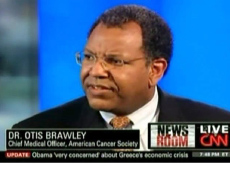False positives

by Kay Torrance
The American Cancer Society's chief medical officer interprets what recent cancer statistics really mean to your health
Most likely, you’ve heard the instruction before. The American Cancer Society (ACS) advises women to get an annual mammogram beginning at age 40. But wait! The U.S. Preventive Services Task Force says otherwise. According to that group, which is an independent panel of 15 health care experts, women don’t need a routine mammogram in their 40s, and for women between 50 and 74, the group recommends mammograms only every two years.
Confused? A lot of women are. And Emory oncologist Otis Brawley understands why. As chief medical officer at the ACS, he’s on the front lines of the public discourse on cancer guidelines.
There are plenty of ingredients bubbling in the stew of medical news, he says. Sometimes, despite good intentions, the media, doctors, advocacy groups, and government agencies all contribute to making the taste a little bitter when it comes not only to mammography but other cancer diagnostic tests as well.
Communication malpractice?
Take, for example, the recent mammography guidelines recommended by the U.S. Preventive Services Task Force. Based on a review of several research studies, its report advises that women in their 40s need an annual mammogram only if they have a family history of breast cancer. The task force even commissioned its own study that showed for every 1,000 women who were screened beginning at age 40, only 0.7 deaths would be prevented and that 470 women would receive a false-positive result and another 33 would undergo an unnecessary biopsy.
|
|
“What came out in the media was that women in their 40s shouldn’t have mammograms, ” Brawley says. “Communication mis-practice may be communication malpractice.” The ACS’s recommendations also have been misheard at times too. The bottom line? “What we are saying is that mammography is imperfect,” says Brawley. “There are false-positives and false-negatives, but the ACS recommends that women in their 40s get a mammogram.”
While Brawley favors mammograms, he would like the media to move beyond the focus on breast self-exams. “I wish it didn’t exist,” he says.
Why? Done properly, a breast self-exam should take about 20 minutes every month. But studies have contradicted its effectiveness. “That message has been difficult to get out,” Brawley says.
In one study, for example, half of the participants were taught how to properly do a self-exam. The other half were told simply to go see their doctor should they feel something abnormal while showering or dressing. The death rate from breast cancer was the same in both groups, and the biopsy rate in the self-exam group was almost two times higher than in the other group. In other words, two times as many women in the self-exam group went through unnecessary biopsies.
Men too
Likewise, some 30 million men in the United States have heard confusing messages about prostate cancer screening. That’s the number of U.S. men who undergo testing for prostate specific antigen (PSA) each year. The American Urological Association and the American College of Radiology would like to see every man aged 50 and older get annual PSA screening.
PSA screening, however, has come under fire. While elevated PSA levels can indicate the presence of prostate cancer, men with a high level may be healthy, and those with low counts may have cancer. The test is known to detect only 3.8% of prostate cancers, which may help explain why the prostate cancer rate has held steady for almost two decades.
“There is a prejudice in the American population that the way to deal with cancer is to find it early,” Brawley says. “Asking the question, ‘Does screening save lives?’ has not been acceptable. I’ve gone before pro-screening urologists and posed the following question: ‘Suppose I had a pill that you take every day for 10 years, and that pill will definitely double your lifetime risk of cancer from 10% to 20% but decrease your relative risk of 3% down to 2.4%.’ The urologists said ‘no,’ they wouldn’t take such a pill, but those numbers match those for screening for PSA.”
The ACS recommends that men 50 and older seriously consider the potential risks of treatment before deciding whether to be screened. Like mammography, prostate cancer screening can produce false-positive results, which, in turn, can lead to unnecessary biopsies. Treatments for prostate cancer may lead to impotence and urinary incontinence without actually prolonging life or enhancing its quality.
The ACS guideline follows last year’s publication of the two largest studies to date on the screening test. A U.S. study showed that over a period of seven to 10 years, screening failed to reduce the death rate in men 55 and older. A European study showed that to eliminate one death from prostate cancer, more than 1,400 men would need to be screened, and 48 additional cases of prostate cancer would need to be treated.
The pathologist who discovered the PSA, Richard Albin, was pleased to see the stand by the ACS earlier this year. “Prostate cancer may get a lot of press, but consider the numbers: American men have a 16% lifetime chance of receiving a diagnosis of prostate cancer, but only a 3% chance of dying from it,” he wrote in a New York Times editorial in the days following the recommendation. “As I’ve been trying to make clear for many years now, PSA testing can’t detect prostate cancer and, more important, it can’t distinguish between the two types of prostate cancer—the one that will kill you and the one that won’t.”
Catch-22
Breast and prostate cancer guidelines are examples of what could be called a health care Catch-22. Doctors want their patients to have all possible information to make informed health care decisions, and the media plays a big part in conveying information to the public.
“But the more information you send, the more you dilute the message. We end up diminishing other messages about preventing sexually transmitted diseases, exercise, and diet, and these are things that actually do save lives,” Brawley says. “We spend a lot of time worrying about treatments—there are so many. What we need is comparative effectiveness research on treatments. Unfortunately, these studies are not getting funded.”
What the public hears and gets behind is often what gets funded, he says, noting that breast and prostate cancers are top recipients of research grants. Other less prominent but deserving conditions receive less media attention and thus less funding and attention.
“Nationally, our cancer research effort is $6 billion a year, and that’s the highest it’s ever been,” says Brawley. “Meanwhile, the surge in Iraq is costing us $11 billion a month. I really think that we don’t spend enough money on cancer research. It’s kind of a drop in the bucket.”-EH
Sensationalizing the statisticsMedia coverage of many medical stories often over-promote claims and exaggerate benefits, says Emory oncologist and American Cancer Society chief medical officer Otis Brawley. “Gone from much of the media these days are professional science writers who really understand the material,” he says. “Recently I talked with a reporter from a major newspaper and had to explain the difference between statistically significant and clinically significant.” Study results may be statistically significant, he explains, without being clinically so. For example, suppose we have a study showing that taking aspirin can decrease risk of heart attack in people who have already had one heart attack. Enough patients in the study were found to benefit from aspirin, so the results are statistically significant. But how much does any one person in the study benefit? If the study found only a 2% reduction in the occurrence of heart attack, its results would not be clinically significant. The percentage of reduction for any one person was small enough to lack practical relevance. Statistical significance is important to help researchers interpret data but should be used with care by reporters who don’t really understand what they mean, Brawley says. Reporters need to know how to read findings of research studies. For example, this past June, a story about an experimental vaccine to prevent breast cancer grabbed the media’s attention. The headline, “Cleveland Clinic doctor reports a possible vaccine to prevent breast cancer,” appeared in many newspapers and on broadcasts across the country. But dig a little deeper, and the story seems less captivating, says Brawley. The experimental vaccine was tested only in mice. Although clinical trials in humans may be years down the road, researchers have been curing breast cancer in mice for years but have found few breast cancer drugs that succeed in humans. On average, only one out of every 250 drugs in lab studies or animal models gets approved. |
||



